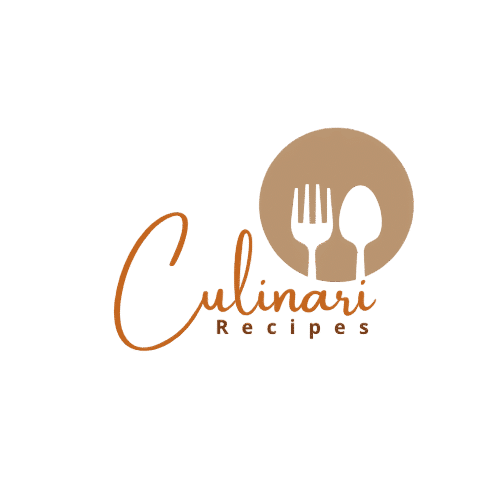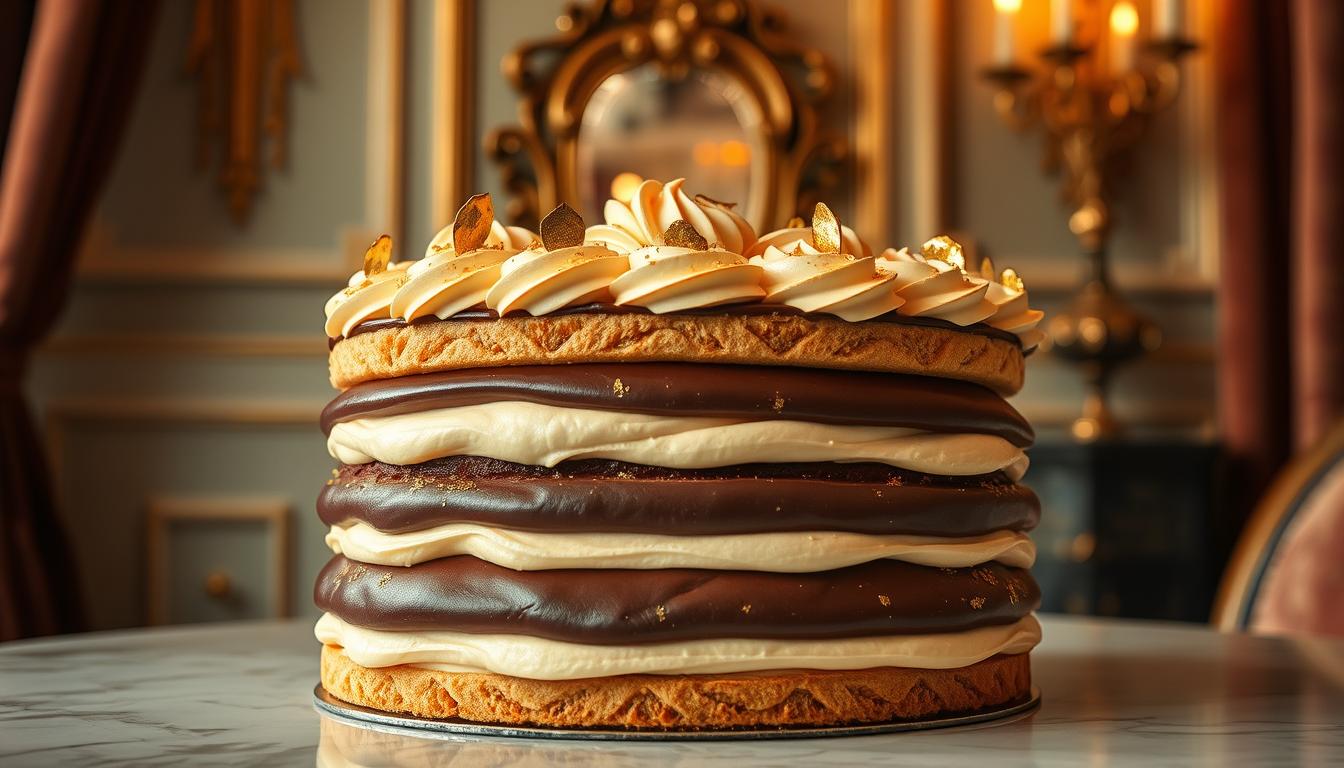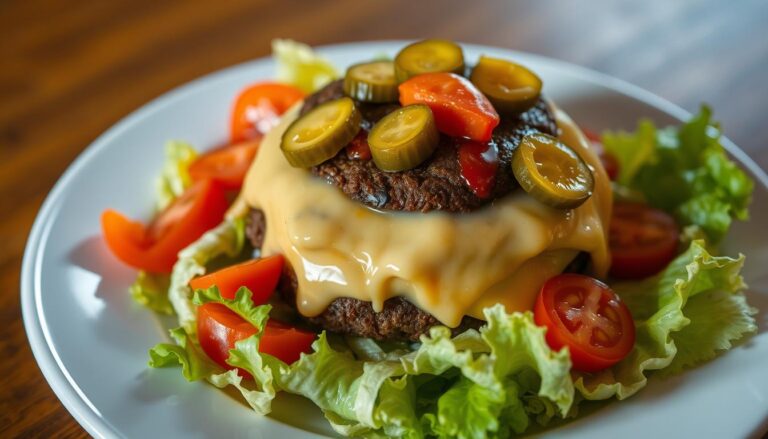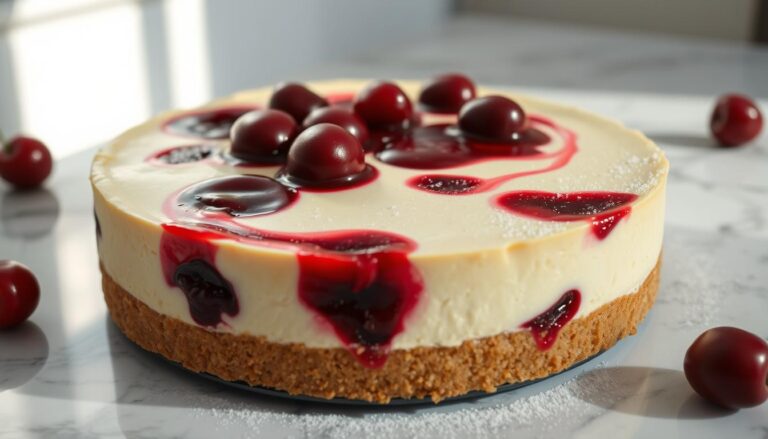Mastering the Art of the Opera Gateau
Imagine a dessert so elegant, it feels like a standing ovation in every bite. That’s the Classic Opera Cake. It’s a French dessert with layers of coffee-soaked almond sponge, silky buttercream, and rich chocolate ganache. It’s all wrapped in a glossy glaze.
You’re about to learn how to make this French patisserie masterpiece. It takes precision and patience. With this guide, you’ll discover how to craft the perfect Opera Gateau. It’s a treat for any dessert lover.
Table of Contents
The Rich History of the Opera Gateau
The Opera Gateau’s story starts in 1950s France. It was a new dessert back then. Now, it’s a favorite in French patisseries and loved by many around the world.
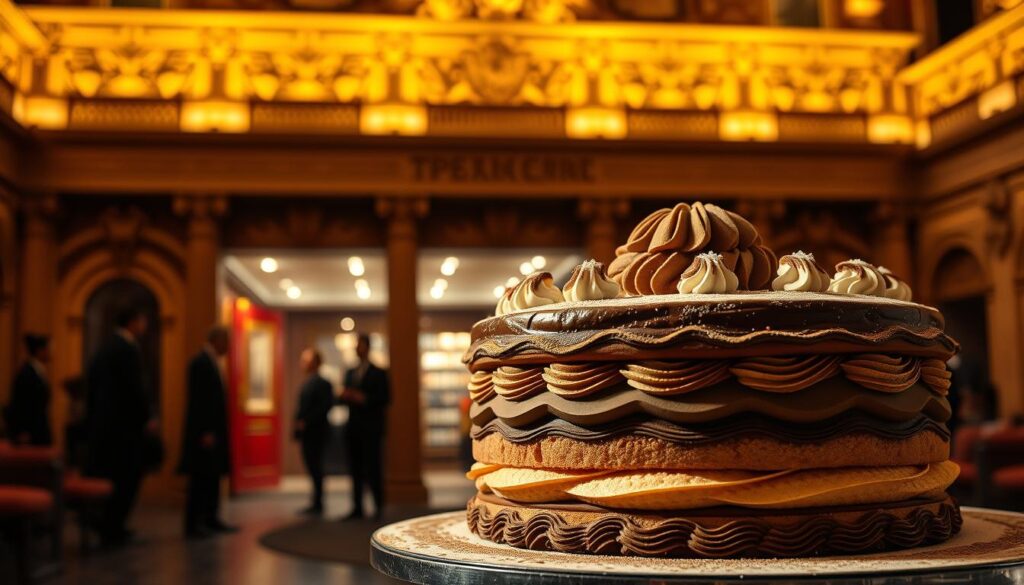
Origins in French Patisserie Tradition
The Opera Gateau is often credited to Parisian patisserie Dalloyau. But, some say similar cakes were around before. This dessert shows the creativity of French patissiers.
Its multi-layered structure and rich flavors have made it a classic. It’s loved by many.
| Year | Event | Significance |
|---|---|---|
| 1950s | Introduction of Opera Gateau | Revolutionized French patisserie |
| 1960s | Popularization in Paris | Became a staple in patisseries |
| Present | Global appreciation | Continues to be a favorite dessert |
Evolution of the Classic Opera Cake
The Opera Gateau has changed over time but stayed true to itself. Many patisseries and chefs have put their own twist on it. This has led to a variety of flavors and styles.
Yet, the core of the Opera Gateau remains the same. It still charms dessert fans with its coffee and chocolate taste.
Exploring French patisserie is richer with knowledge of the Opera Gateau’s history and evolution. It shows why this dessert is so beloved.
Understanding the Opera Gateau: Layers and Flavors
To truly appreciate the Opera Gateau, one must examine its layered structure and the balance of its primary flavors: coffee and chocolate. This dessert is not just a treat for the taste buds but also a marvel of culinary engineering.
The Signature Six-Layer Structure
The Opera Gateau is characterized by its six-layer structure. It includes coffee-soaked almond sponge, coffee buttercream, and rich chocolate ganache. Each layer plays a crucial role in the overall taste and texture of the dessert.
- Joconde sponge cake: Provides a delicate almond flavor and a soft texture.
- Coffee syrup: Adds moisture and a deep coffee flavor.
- Coffee buttercream: Contributes a creamy texture and a balanced coffee taste.
- Chocolate ganache: Offers a rich, velvety chocolate experience.
The harmony among these layers is what makes the Opera Gateau so unique. The combination of textures and flavors creates a complex yet balanced taste experience.
| Layer | Component | Contribution |
|---|---|---|
| 1 | Joconde Sponge | Delicate almond flavor |
| 2 | Coffee Syrup | Moisture and coffee flavor |
| 3 | Coffee Buttercream | Creamy texture and coffee taste |
| 4 | Joconde Sponge | Delicate almond flavor |
| 5 | Coffee Buttercream | Creamy texture and coffee taste |
| 6 | Chocolate Ganache | Rich, velvety chocolate |
The Perfect Balance of Coffee and Chocolate
The Opera Gateau’s flavor profile is dominated by the interplay between coffee and chocolate. The coffee flavor comes from both the coffee syrup and the coffee buttercream, while the chocolate ganache provides a deep, rich chocolate taste.
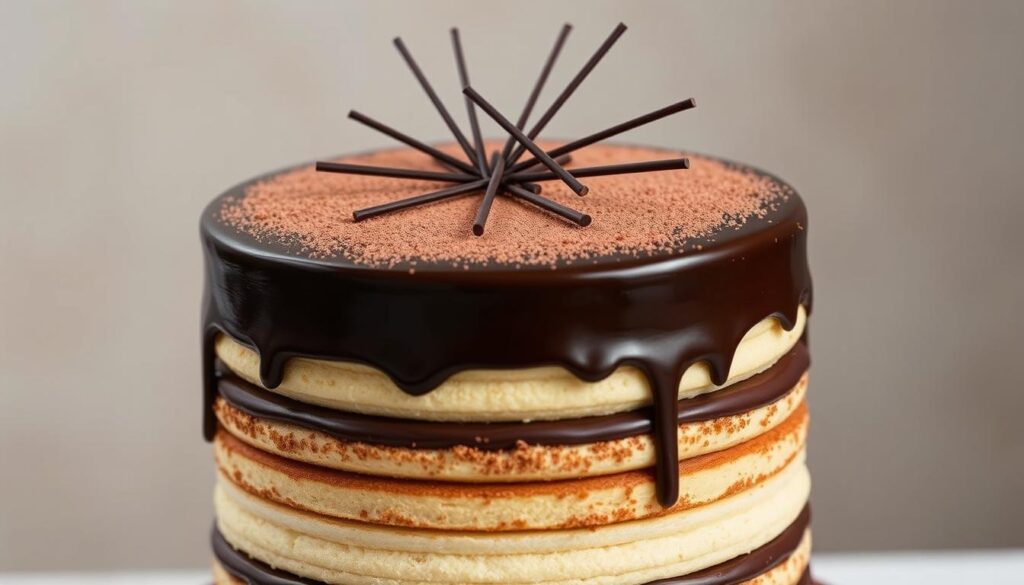
Achieving the perfect balance between these flavors is crucial. Too much coffee can overpower the dessert, while too little may make it taste bland. The chocolate ganache must be rich enough to complement the coffee flavors without overwhelming them.
The key to this balance lies in the quality of the ingredients and the precision of their preparation. High-quality coffee and dark chocolate are essential for creating a harmonious flavor profile.
Essential Ingredients for an Authentic Opera Gateau
To make a real Opera Gateau, you need to know the key ingredients. The quality of these ingredients affects the taste, texture, and look of the cake.
The Joconde Sponge Components
The Joconde sponge is a key part of the Opera Gateau. It has a light almond flavor and a soft texture. It’s made from almond flour and eggs.
Selecting Quality Almond Flour
Almond flour is the heart of the Joconde sponge. It gives the sponge its flavor and structure. Choose a finely ground almond flour with a consistent texture. High-quality almond flour makes the sponge tender and flavorful. Brands like Bob’s Red Mill or Blue Diamond are good choices.
Importance of Fresh Eggs
Fresh eggs are crucial for the Joconde sponge. They add moisture, richness, and stability. Using room temperature eggs helps the batter mix smoothly and bake evenly. Fresh eggs are key for the cake’s layers.
| Ingredient | Quality Indicator | Impact on Joconde Sponge |
|---|---|---|
| Almond Flour | Fine grind, consistent texture | Tender crumb, delicate almond flavor |
| Eggs | Freshness, room temperature | Moisture, richness, structural integrity |
Coffee Syrup and Buttercream
The coffee syrup and buttercream are key to the Opera Gateau’s taste. A strong coffee syrup is needed, made with quality coffee. The buttercream should be smooth and creamy, balancing the coffee’s boldness.
“The art of making Opera Gateau lies in the balance of its flavors. Coffee and chocolate must be in harmony.”
Chocolate Ganache Selection
The dark chocolate ganache is the top layer of the Opera Gateau. It adds a deep, velvety finish. Choose a dark chocolate with at least 70% cocoa content for the best taste. The ganache should be smooth and shiny, adding luxury to the cake.
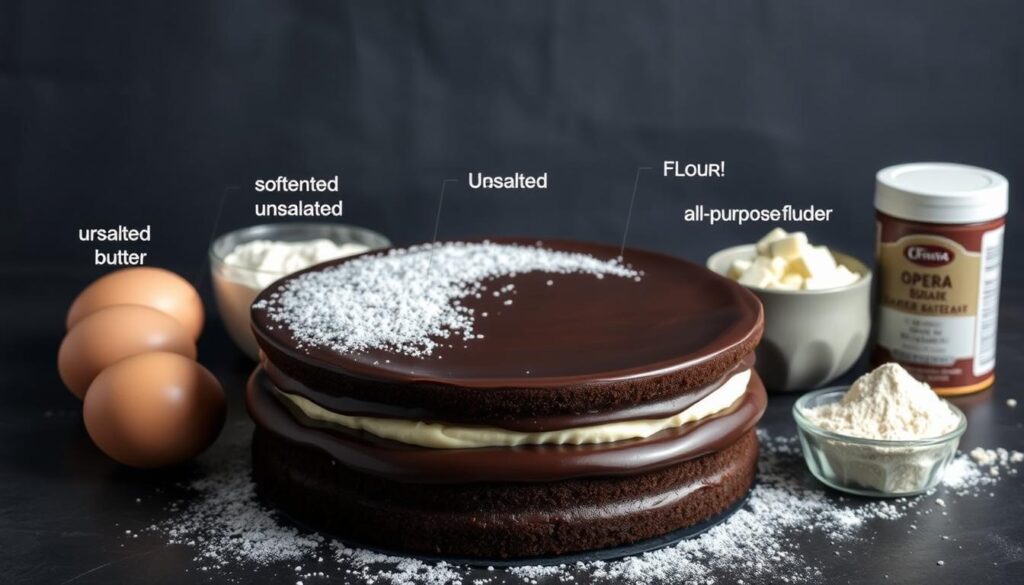
By focusing on these key ingredients and their quality, you can make an Opera Gateau that’s both authentic and beautiful. Mastering this French dessert starts with understanding and choosing the right ingredients.
Equipment and Preparation Techniques
To make an Opera Gateau like the pros, you need the right tools and techniques. This cake is complex, needing precision and the right tools for the perfect result.
Must-Have Tools for Baking Success
For baking an Opera Gateau, the right tools are key. You’ll need a digital scale for exact measurements. A mixing bowl set is needed for different parts of the cake. A silicone mat or parchment paper is essential for baking the sponge layers.
A whisk and a rubber spatula are vital for mixing and folding ingredients. A turntable helps when assembling the cake, making it easy to access all sides.
| Tool | Purpose |
|---|---|
| Digital Scale | Accurate ingredient measurement |
| Mixing Bowl Set | Preparing different cake components |
| Silicone Mat or Parchment Paper | Baking sponge layers |
Setting Up Your Workspace
Before starting, set up your workspace efficiently. Clear a large, flat area and organize your tools and ingredients. This makes your work flow better and cuts down on mistakes.
“A cluttered workspace leads to a cluttered mind,”
With the right tools and a tidy workspace, you’re ready to tackle the Opera Gateau. This setup ensures a smooth baking process and a high-quality final product.
Step-by-Step Opera Gateau Recipe
With this guide, you can make an Opera Gateau that tastes great and looks amazing. You’ll need to make the joconde sponge, coffee buttercream, and chocolate ganache. Then, layer them carefully.
Preparing the Joconde Sponge
The joconde sponge is key to the Opera Gateau. It adds a delicate texture that goes well with the coffee and chocolate. Start by mixing the batter right.
Mixing the Batter Properly
First, mix almond flour and confectioner’s sugar in a bowl. In another bowl, whip egg whites until frothy. Then, add granulated sugar slowly. Fold the egg mixture into the almond flour mix gently.
Baking to Perfect Thinness
Spread the batter on a baking sheet for a thin layer. Bake at 425°F (220°C) for 5-7 minutes, until it’s lightly golden. Let it cool before cutting into layers.
Creating the Perfect Coffee Buttercream
Coffee buttercream is vital for the Opera Gateau. Whip butter until fluffy, then add coffee syrup and powdered sugar slowly. Keep whipping until it’s smooth and creamy.
Making Silky Chocolate Ganache
To make chocolate ganache, heat heavy cream until it simmers. Pour it over chopped dark chocolate in a bowl. Wait a minute, then stir until it’s smooth and shiny.
Assembling the Layers
To build the Opera Gateau, start with a joconde sponge layer on a plate. Brush it with coffee syrup, then add coffee buttercream. Keep layering, ending with chocolate ganache on top.
By following these steps, you’ll make an Opera Gateau that’s both tasty and beautiful. Its layered structure is a key part of its appeal.
Mastering the Art of Decoration
To show off your Opera Gateau like a pro, you need to get good at decorating. This cake is famous for its shiny top and sharp edges. It’s a fancy dessert perfect for any event.
Creating the Signature Glossy Top
The glossy top comes from a smooth layer of chocolate ganache. To get it right, make sure your ganache is ready. Heat the chocolate and cream mix until it’s between 95°F and 100°F. Stir constantly to avoid burning.
Let the ganache cool a bit until it’s spreadable. Then, pour it over the cake’s top layer. Use an offset spatula to spread it evenly. This will give your cake that shiny look.
Precision Cutting Techniques
Cutting your Opera Gateau right is as key as putting it together. Use a sharp, heated knife for clean cuts. Dip the knife in hot water, then wipe it dry before cutting. Do this for each slice, heating the knife as you go.
| Cutting Technique | Description | Tip |
|---|---|---|
| Heated Knife | Dip knife in hot water, wipe dry | Reheat between cuts |
| Smooth Cut | Gentle, even pressure | Avoid applying too much pressure |
| Clean Edge | Wipe knife clean between cuts | Prevents ganache from sticking |
With these decoration tips, your Opera Gateau will look like a work of art. It will be a fancy treat for any party.
Common Challenges and Troubleshooting
When making Opera Gateau, you might run into some common problems. But don’t worry, these can be fixed with the right steps. Making this fancy dessert needs care and patience. With some tips, you can get it right and enjoy a great baking experience.
Preventing Dry Sponge Layers
One big issue is dry sponge layers. To avoid this, don’t overbake your Joconde sponge. Check it often towards the end of baking. It should be lightly golden and spring back when touched.
Also, make sure to soak the sponge layers well with coffee syrup. This keeps them moist.
Tip: Use high-quality coffee for the syrup. It makes the flavor better and keeps the sponge moist.
Achieving the Perfect Ganache Consistency
Ganache’s consistency is key for the Opera Gateau’s look and feel. If it’s too thin, it won’t set right. If it’s too thick, it won’t spread well. To get it just right, heat your cream to 180°F to 190°F before mixing it with chocolate.
Let it sit for a few minutes to melt the chocolate. Then, stir it gently until it’s smooth.
“The quality of chocolate is paramount. Using high-quality chocolate with a high cocoa content will result in a richer, more stable ganache.”
Fixing Buttercream Issues
Buttercream can be tricky, but there are fixes for common problems. If it’s too thin, chill it for 10 to 15 minutes. Then, whip it again until it’s firm.
If it’s too thick, heat it in short bursts in the microwave. Stir between each heating until it’s right.
By tackling these common issues, you’ll be well on your way to a beautiful and tasty Opera Gateau. Remember, practice makes perfect. So, don’t get discouraged by any initial mistakes.
Variations on the Classic Opera Gateau
Looking to mix up the classic Opera Gateau? There are many ways to do it with seasonal ingredients and new flavors. The traditional recipe is great, but you can make it your own. This makes it perfect for any event.
Seasonal Flavor Adaptations
Seasonal flavors can make the Opera Gateau even better. In autumn, add warm spices like cinnamon or nutmeg to the syrup or buttercream. This gives it a cozy taste. In summer, fresh fruit like raspberries or strawberries can add a fruity twist. It’s a fresh take on the classic.
Here’s a simple table showing seasonal ingredients you can use:
| Season | Ingredients |
|---|---|
| Spring | Lemon, Orange Blossom Water |
| Summer | Raspberries, Strawberries |
| Autumn | Cinnamon, Nutmeg, Caramel |
| Winter | Ginger, Cloves, Cranberries |
Modern Interpretations
Modern bakers are always trying new things with the Opera Gateau. They might use different types of coffee like espresso con panna or café au lait. Or, they might add unique ingredients like matcha or lavender to the cake or buttercream. This gives it a fresh twist.
By trying out different flavors and ingredients, you can make your own unique Opera Gateau. Whether you’re using seasonal flavors or trying something new, it’s a dessert that can be enjoyed in many ways.
Conclusion: Enjoying Your Masterpiece Opera Gateau
Creating an Opera Gateau takes patience and practice. It’s a rich dessert that combines coffee, chocolate, and creamy buttercream. When you take a bite, the joconde sponge, coffee syrup, and chocolate ganache come together beautifully.
The Opera Gateau is more than just a dessert; it’s an experience. You can try new flavors and ingredients to make it unique. Swap the coffee syrup for something else or use different chocolates for the ganache. The options are endless, leading to a delicious treat every time.
As you get better at making this classic dessert, it’s perfect for special moments or just for yourself. So, be creative and enjoy the rich flavors of your Opera Gateau.
